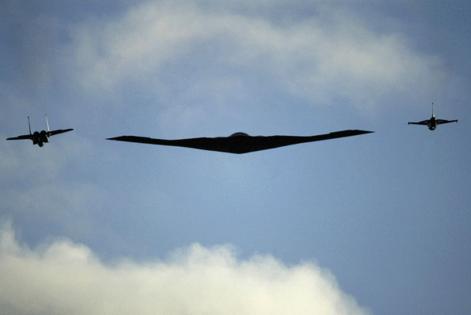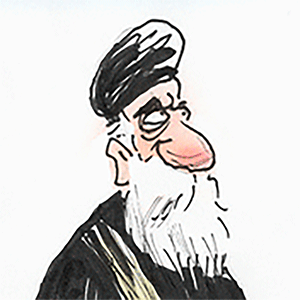The bombs the US could deploy if Trump strikes Iran
Published in News & Features
WASHINGTON — U.S. President Donald Trump has a wide range of military assets in the Middle East and across the globe to bring to bear in a potential fight against Iran as he weighs one of the most momentous foreign policy decisions of his administration.
That arsenal includes powerfully destructive bombs, long-range stealth bombers, an aircraft carrier strike group, Navy destroyers and U.S. troops — offering Trump multiple options if he decides to intervene more directly in support of Israel. Some resources like the B-2 bomber are in the U.S. while other assets are either in the region or on the way.
It’s unclear whether Trump will deepen U.S. involvement beyond helping Israel defend against Iranian air attacks as he has done in recent days. On Tuesday afternoon, the president gathered his national security staff for a White House Situation Room meeting.
The administration, though, has been surging military resources to U.S. Central Command, which oversees the Pentagon’s operations in the region. And forces already in the area include naval and air power that could play a crucial role in any U.S. action against Iran.
The Islamic Republic has already suffered its worst assault in decades, with Israel’s strikes on the country’s nuclear and military infrastructure damaging key facilities and killing senior personnel. One weapon, though, is seen as particularly effective if the situation were to escalate and draw the direct involvement of the U.S.
The Massive Ordnance Penetrator or “MOP” — better known as the bunker-buster bomb — weighs 30,000 pounds and is the world’s largest precision-guided weapon. The GPS-directed bomb, assembled by Boeing Co., has been touted repeatedly as the only weapon capable of delivering a knockout blow to Tehran’s atomic ambitions, which would require a successful strike on the heavily protected enrichment site at Fordow.
Hidden beneath a mountain and believed to be buried around 60 to 90 meters deep, many experts believe that damaging Fordow can be achieved only by the MOP — a weapon the U.S. alone possesses.
Each bunker buster can be independently targeted and released, “making it possible to deliver a MOP right on top of another MOP,” said Rebecca Grant, a Lexington Institute analyst. Grant said drone surveillance in the area could also help the military “refine the strike” at the last minute and noted that Iranian nuclear facilities such as Fordow have been studied by the U.S. for years.
The decision on whether to use that weapon is poised to be one of the most critical Trump makes. The bomb could alter Iran’s decision-making over its nuclear program and because its deployment would involve American planes and pilots it would place the U.S. at the center of an offensive military action.
“If Israel can achieve that result through its operations, that is the best case,” said Daniel Shapiro, a former U.S. ambassador to Israel and onetime deputy assistant defense secretary. “But if it requires U.S. participation to target the Fordow facility, that has to be on the table for President Trump to consider.”
Deploying the MOP would involve another crucial military asset, the B-2 stealth bomber, which can carry two of them. The B-2 would fly thousands of miles from Whiteman Air Force Base in Missouri to deliver the bombs deep within Iran.
The U.S. demonstrated the power of its B-2 fleet in October, when bombers flew from Whiteman to hammer Iran-backed Houthi weapons facilities buried underground. Earlier this year, as many as six B-2s were spotted on a runway on the island of Diego Garcia in the Indian Ocean in a deployment that was interpreted by many as a message to both Iran and the Houthis. The Air Force said those aircraft returned to their base in May.
US Central Command, which oversees the longstanding US military presence in the Middle East, would play a key role in any operations on Iran, with responsibility for a force spread across multiple countries, including Egypt, Jordan, Qatar, Saudi Arabia and the UAE, and drawing on troops from different military services and special operations forces.
Defense Secretary Pete Hegseth has “directed the deployment of additional capabilities” to the command. The administration is also sending as many as 20 KC-135 and newer KC-46 aerial refueling tankers to undisclosed locations, according to a defense official, helping extend the range of U.S. air power.
Those resources would offer Trump additional flexibility in determining his course of action. U.S. personnel in the region, including Army, Air Force, Marine Corps and Navy servicemembers, number 40,000-45,000, according to the most recent Central Command figures.
The Navy is also poised to be a critical component, with resources that can both aid any action on Iran and have already been employed to help protect Israel from retaliatory strikes.
The USS Carl Vinson aircraft carrier strike group has been in the region of the Arabian Sea for seven months. The ship carries about 3,000 sailors, according to the Navy, with another 2,000 in its air wing.
The air wing boasts an extensive array of military hardware, including F-35 and F-18 fighter jets, EA-18 aircraft that can disrupt enemy radar and communication systems, E-2Ds with advanced radar to help identity threats more quickly, as well as Osprey tiltrotor aircraft and Sea Hawk helicopters.
In addition to the centerpiece carrier, the group also includes a guided-missile cruiser, the USS Princeton, and guided-missile destroyers. Another strike group headed by the USS Nimitz is scheduled to relieve the Vinson and is currently in the Indo-Pacific, offering additional forces.
The Navy has three Aegis missile defense destroyers in the Eastern Mediterranean — the USS Arleigh Burke, USS The Sullivans and the USS Thomas Hudner, with two more vessels arriving shortly, according to a defense official. Two additional destroyers are in the Red Sea.
A U.S. official said the Arleigh Burke and The Sullivans fired numerous SM-3 anti-ballistic missile interceptors over the weekend to help defend Israel. An Army unit in the region also fired THAAD interceptors at Iranian ballistic missiles, according to another official.
_______
(With assistance from Natalia Drozdiak.)
©2025 Bloomberg L.P. Visit bloomberg.com. Distributed by Tribune Content Agency, LLC.







Comments